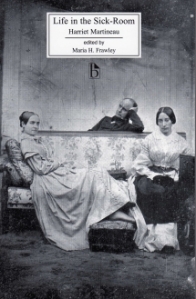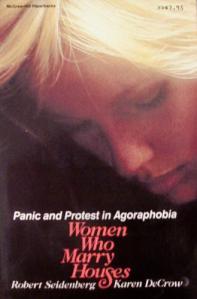 June
12
June
12
Tags
Harriet Martineau: Agoraphobia and Feminist Freedom
 On the 12th of June 1802, pioneering sociologist Harriet Martineau was born in Norwich, England. In 1844 she wrote one of her most underrated books, Life in the Sickroom: Essays by an Invalid, a sociological investigation of illness in Victorian England, as well as an autobiographical reflection on convalescence. Written during a five year retreat to Tynemouth, this book clearly bears the struggles of a 19thcentury bright and educated woman in finding her place in a patriarchal society and, subsequently, coming to terms with her newly found status. At the time, Martineau was in the prime of her intellectual powers and her critical success, so Diana Postlethwaite ass the question of why the woman who had once lashed herself to the binnacle of a ship to watch a hurricane while she was en route to a two-year journey through the American wilderness was abruptly transformed? It seems that within a very brief period of time, Martineau became a neurasthenic invalid filled with an “unspeakable longing for stillness and solitude,” who experienced many of the classic symptoms of hysteria. “Though her illness was diagnosed as a uterine tumour, Martineau believed that it was at least in part psychosomatic: “the result of excessive anxiety of mind,-of the extreme tension of nerves under which I had been living for some years.”‘ For five years, Harriet Martineau lay on a chaise lounge at Tynemouth and watched the world through a telescope. In 1845, she announced her miraculous cure by the powers of mesmerism. What transformed Harriet Martineau from a competent, successful woman into a dependent invalid? More significantly, what restored her? The answers to these questions lie beyond the notions of “gender-free patterns of human development” that are attributed to her. Martineau’s apparently easy successes in the 1820s and 1830s had left unresolved the conflicts and needs of her female nature, which arose as a result of her relationship with her mother. At the heart of Harriet Martineau’s Tynemouth experience lay questions of gender and identity.” (Diana Postlethwaite, ‘Mothering and Mesmerism in the Life of Harriet Martineau’, Signs, Vol. 14, No. 3, Spring, 1989).
On the 12th of June 1802, pioneering sociologist Harriet Martineau was born in Norwich, England. In 1844 she wrote one of her most underrated books, Life in the Sickroom: Essays by an Invalid, a sociological investigation of illness in Victorian England, as well as an autobiographical reflection on convalescence. Written during a five year retreat to Tynemouth, this book clearly bears the struggles of a 19thcentury bright and educated woman in finding her place in a patriarchal society and, subsequently, coming to terms with her newly found status. At the time, Martineau was in the prime of her intellectual powers and her critical success, so Diana Postlethwaite ass the question of why the woman who had once lashed herself to the binnacle of a ship to watch a hurricane while she was en route to a two-year journey through the American wilderness was abruptly transformed? It seems that within a very brief period of time, Martineau became a neurasthenic invalid filled with an “unspeakable longing for stillness and solitude,” who experienced many of the classic symptoms of hysteria. “Though her illness was diagnosed as a uterine tumour, Martineau believed that it was at least in part psychosomatic: “the result of excessive anxiety of mind,-of the extreme tension of nerves under which I had been living for some years.”‘ For five years, Harriet Martineau lay on a chaise lounge at Tynemouth and watched the world through a telescope. In 1845, she announced her miraculous cure by the powers of mesmerism. What transformed Harriet Martineau from a competent, successful woman into a dependent invalid? More significantly, what restored her? The answers to these questions lie beyond the notions of “gender-free patterns of human development” that are attributed to her. Martineau’s apparently easy successes in the 1820s and 1830s had left unresolved the conflicts and needs of her female nature, which arose as a result of her relationship with her mother. At the heart of Harriet Martineau’s Tynemouth experience lay questions of gender and identity.” (Diana Postlethwaite, ‘Mothering and Mesmerism in the Life of Harriet Martineau’, Signs, Vol. 14, No. 3, Spring, 1989).
Although Martineau believed that she was cured by mesmerism (a different name for a form of hypnosis fashionable at the time, hailing from a concept called animal magnetism), it was proved that it was in fact the tumour shifting which eased her state. Her autobiographical work upset her contemporaries who “thought it dangerous in ‘its supposition of self-reliance'”. Martineau dedicated it to Elizabeth Barrett, the prominent Victorian poet, as it was an outpouring of feeling to an idealized female alter ego, both professional write r and professional invalid- and utterly unlike the women in her own family. Written during a kind of public separation from her mother, this book was Martineau’s declaration of independence, as well as a way of a female patient to go beyond male medical control and take charge of her illness. Her critics, the British and Foreign Medical Review amongst them, suggested that as she was an invalid, her mind must also be sick and the work was not to be taken seriously and the publication recommended that patients follow “unconditional submission” to the advice of doctors. It is also interesting to point out that “[in the nineteenth century], few women wrote and published their autobiographies, and virtually no women wrote within the main tradition of the spiritual autobiography or, like Martineau, attempted one of the secular variants so common for male writers.” (Linda H. Peterson, Victorian Autobiography: The Tradition of Self-Interpre- tation (New Haven, Conn.: Yale University Press, 1986).
r and professional invalid- and utterly unlike the women in her own family. Written during a kind of public separation from her mother, this book was Martineau’s declaration of independence, as well as a way of a female patient to go beyond male medical control and take charge of her illness. Her critics, the British and Foreign Medical Review amongst them, suggested that as she was an invalid, her mind must also be sick and the work was not to be taken seriously and the publication recommended that patients follow “unconditional submission” to the advice of doctors. It is also interesting to point out that “[in the nineteenth century], few women wrote and published their autobiographies, and virtually no women wrote within the main tradition of the spiritual autobiography or, like Martineau, attempted one of the secular variants so common for male writers.” (Linda H. Peterson, Victorian Autobiography: The Tradition of Self-Interpre- tation (New Haven, Conn.: Yale University Press, 1986).
It is possible that today, Martineau’s five-year retreat could be diagnosed as agoraphobia. In their feminist study of the disease, Robert Seidenberg and Karen DeCrow demonstrated that agoraphobia, like hysteria, enables the patient to act out a “caricature of the feminine sex role.” The agoraphobe is a “strict constructionist” of the dictum “woman’s place is in the home.” Like the hysteric, the agoraphobic woman vents her frustration and anger by precisely acting out the role expected of her gender: “Being homebound is a major part of the process of becoming feminine. In this interior setting she is taught the home arts of working, serving, and cleaning as well as the rehearsals for the role of mothering. She sees her mother … doing these things. They define femininity for her.” (Robert Seidenberg and Karen DeCrow, Women Who Marry Houses: Panic and Protest in Agoraphobia, 1983). “Thus the retreat to Tynemouth, while it served to distance Martineau from her mother [whom she resented for providing a permanent limiting role model], did not in itself resolve the deep conflicts she felt between the tremendous success she had experienced as a woman of letters and the powerful messages she had received from  her mother as to appropriate feminine behaviour (…) Nevertheless, Martineau’s sickroom was transformed from a cloistered retreat into a place of visionary perspective. Her incarceration became a willful achievement of independence.” (Diana Postlethwaite). Life in the Sickroom is not only an expression of ideas of social and health reform, but also a proof of female self-discovery. At Tynemouth, Martineau had the time and peace to think for herself, and to find a healing inner vision. She did not end up rejecting her femaleness, but by living it, coming to terms with its complexities and redefining it to suit her nature, Martineau conquered the difficulties that were associated with being a woman in her time. This series of essays chronicles the process of finally being able to honestly express deeply felt emotions; and to move toward a sense of identification and community with other women that would free her from the restrictive identification with her mother, whom she regarded as a vestige of a patriarchal social system she now knew was on the cusp of change.
her mother as to appropriate feminine behaviour (…) Nevertheless, Martineau’s sickroom was transformed from a cloistered retreat into a place of visionary perspective. Her incarceration became a willful achievement of independence.” (Diana Postlethwaite). Life in the Sickroom is not only an expression of ideas of social and health reform, but also a proof of female self-discovery. At Tynemouth, Martineau had the time and peace to think for herself, and to find a healing inner vision. She did not end up rejecting her femaleness, but by living it, coming to terms with its complexities and redefining it to suit her nature, Martineau conquered the difficulties that were associated with being a woman in her time. This series of essays chronicles the process of finally being able to honestly express deeply felt emotions; and to move toward a sense of identification and community with other women that would free her from the restrictive identification with her mother, whom she regarded as a vestige of a patriarchal social system she now knew was on the cusp of change.










What a fascinating article. And more books to add to the must-read pile.
LikeLike
Yes, the never-ending list. ..thanks for visiting! 🙂
LikeLike
As a fellow Gemini agoraphobic born in Norwich, England who graduated from an all women’s university (plenty death to the patriarchy there), I think I’ve found my soul-sister! Thank you!
LikeLike
Oh good, we are glad to have brought you together 🙂 ! Thanks for reading.
LikeLike
Reblogged this on Getting To the Market Place and commented:
Why didn’t I write my senior thesis on this? From birthplace to agoraphobe, we have too much in common! I’m so excited to get these books out of the library. Although I don’t relate my agoraphobia to the patriarchy I can’t wait to get reading!
LikeLike
Loved this article – though I see “ass” on the fourth sentence, which I think meant to be “ask”.
Again, thanks for bringing Harriet Martineau to my awareness. 🙂
LikeLiked by 1 person
Have you read ‘Mad, Bad and Sad’ – a study by Lisa Appignanesi? Very insightful on this subject
LikeLike